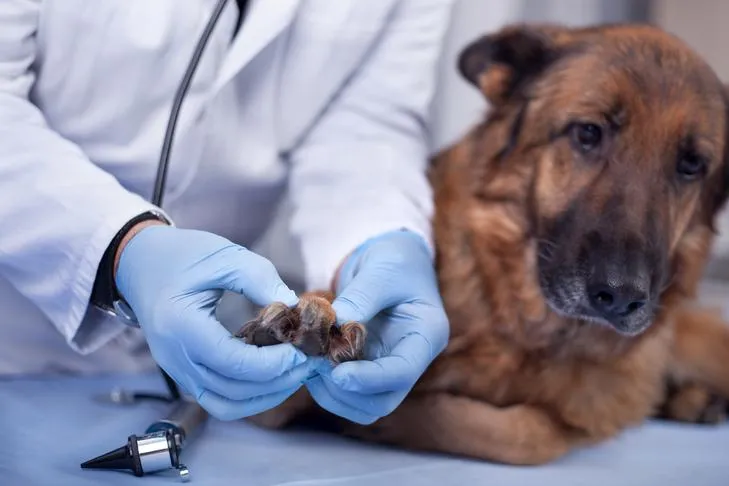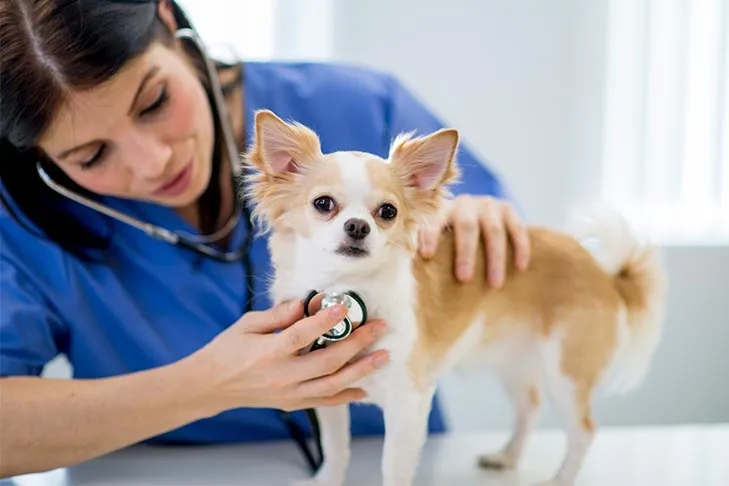Nobody wants to consider their beloved canine companion suffering from worms, and the mere thought of these internal parasites can be unsettling. Unfortunately, intestinal worms are a common health concern for dogs of all ages, with puppies potentially exposed even before birth. As responsible dog owners, understanding the risks, symptoms, and treatment options for worms is crucial to safeguard your dog’s health and protect your family from potential infection. A key question many owners ask is, “Can Worms Be Passed From Dog To Dog?” The short answer is yes, many types of worms are highly transmissible between dogs, primarily through environmental contamination and direct contact.
What Are Worms, and How Are They Harmful to Dogs?
When referring to “worms” in dogs, we are primarily talking about various internal parasites. Most of these, such as roundworms, hookworms, whipworms, and tapeworms, reside in the dog’s intestines. Another critical type, heartworms, live in the dog’s heart, lungs, and associated blood vessels, causing a much more severe and life-threatening condition.
These parasites thrive at the host’s expense, consuming vital nutrients and preventing the dog from reaching its optimal healthy state. This impact is particularly dangerous for newborn and young puppies due to their developing immune systems, but it can affect dogs of all ages, weakening them and leading to various health complications.
Adding to the concern, some of these worms are zoonotic, meaning they can be transmitted from animals to humans. Children are especially vulnerable to contracting parasitic worms because they may play barefoot in contaminated soil or sand containing worm larvae. They can also accidentally ingest larvae present on an infected dog’s fur or from their saliva. To minimize this risk, practicing excellent hygiene is paramount. Dr. Jerry Klein, Chief Veterinarian for the AKC, advises using gloves when handling your dog’s fecal waste and always washing hands thoroughly with soap and warm water afterward. This handwashing discipline should also be instilled in young children, who often put their fingers in their mouths after touching their pets. It’s also important to understand specific risks, such as if roundworms are contagious to humans or if you risk getting roundworms from your puppy.
 Miniature American Shepherd puppy chewing a treat, symbolizing healthy dog care to prevent worm transmission.
Miniature American Shepherd puppy chewing a treat, symbolizing healthy dog care to prevent worm transmission.
Types of Worms and How They Spread from Dog to Dog
The ability of worms to be passed from dog to dog varies by type, but environmental contamination and indirect contact are common themes. Here’s a closer look at the most common worms and their transmission pathways:
Roundworms (Toxocara canis and Toxascaris leonina)
Roundworms are exceptionally common, especially in puppies. Toxocara canis is the more prevalent and dangerous species, capable of causing fatal infections in young pups and transferring to humans. Toxascaris leonina is less common and typically affects older dogs.
These worms live freely in a dog’s intestines and do not require an intermediate host. This makes direct dog-to-dog transmission, often via environmental contamination, very efficient.
- Maternal Transmission: An infected pregnant female dog can pass roundworm larvae directly to her unborn puppies through the placenta. After birth, she can transmit larvae again through her milk to nursing pups. This is a primary reason why puppies are frequently born with roundworms.
- Environmental Contamination: Dogs can contract roundworms by eating or stepping on worm eggs or larvae. Dr. Klein explains that “the worms’ eggs are deposited in the soil via the feces of infected dogs, where the eggs can survive for long periods of time, even in harsh climates.” If a dog sniffs or licks contaminated dirt or grass, they can become infected. In rare instances, larvae can also burrow through the skin of a dog’s paws if they come into close contact with infected soil or sand. This highlights how easily roundworms can spread from one dog to another through shared environments.
Hookworms (Ancylostoma caninum, Ancylostoma braziliense, and Uncinaria stenocephala)
Named for their hook-like appearance, hookworms attach to the wall of a dog’s small intestines. The blood-sucking nature of Ancylostoma caninum can lead to severe anemia, which can be deadly in puppies. While hookworms don’t infect humans in the same way they do dogs, their larvae can burrow into human skin, causing an itchy rash or more serious complications.
Hookworms can spread from dog to dog in several ways:
- Ingestion: Dogs can pick up hookworms by ingesting larvae found in the environment, such as infected soil or feces. They might also lick larvae off their paws after walking through a contaminated area.
- Skin Penetration: Hookworm larvae can directly penetrate a dog’s skin, often through the paws, leading to infection.
- Maternal Transmission: Similar to roundworms, a mother dog can pass hookworm larvae to her puppies through her milk.
- Indirect Transfer: Humans can inadvertently bring hookworm eggs into the home on the bottoms of their shoes, creating a contaminated environment that can infect dogs. It’s important to be aware of the potential side effects of hookworm medication and always consult a vet.
 Veterinarian checking a German Shepherd's paw, illustrating vet examination for worm prevention and detection.
Veterinarian checking a German Shepherd's paw, illustrating vet examination for worm prevention and detection.
Whipworms (Trichuris vulpis)
Whipworms are found in a dog’s large intestine and colon, where they attach to the intestinal wall. Mild infections often show no outward signs, but heavy infestations can lead to significant problems such as diarrhea, bloody stool, weight loss, and anemia. Whipworms are notoriously difficult to diagnose through fecal exams, often requiring repeat testing if symptoms persist.
Fortunately, dog whipworms are not transmitted to humans. However, excellent sanitation practices, such as immediately cleaning up after your dog’s bathroom breaks, are crucial because whipworm eggs are shed in infected dog poop. These eggs are hardy and can survive in the environment for up to five years under favorable conditions, meaning one infected dog can contaminate an area for a very long time, posing a risk to other dogs.
Tapeworms (Dipylidium caninum and others)
Unlike the previously mentioned worms, tapeworms have a more complex life cycle involving an intermediate host. Adult tapeworms live in a dog’s small intestine, but their larvae develop in another animal, such as a flea or a rodent. The most common tapeworm in dogs, Dipylidium caninum, utilizes fleas as its intermediate host.
Transmission from dog to dog, though indirect, relies on the presence of these intermediate hosts:
- Ingestion of Fleas: Dogs become infected by ingesting fleas that carry tapeworm larvae, often while grooming themselves or by consuming flea-infested prey.
- Ingestion of Infected Prey: Other tapeworm species can infect dogs if they ingest infected small animals like rodents or rabbits.
While rare, humans can also become infected with dog tapeworms if they accidentally ingest an infected flea. Mild tapeworm infections might be asymptomatic, but severe cases can hinder a dog’s ability to digest and absorb food properly. Controlling fleas is paramount for controlling tapeworms. Dr. Klein advises a comprehensive flea preventative program with your veterinarian to eliminate fleas from both your dog and their environment. Understanding over-the-counter hookworm treatments is important, but a vet’s advice is crucial for all parasite control.
 Tired Beagle looking unwell, potentially showing symptoms of tapeworm infestation requiring flea control.
Tired Beagle looking unwell, potentially showing symptoms of tapeworm infestation requiring flea control.
Heartworms (Dirofilaria immitis)
Heartworms cause heartworm disease, a preventable but potentially fatal infection leading to severe lung disease and heart failure. Like tapeworms, heartworms require an intermediate host—the mosquito. This means heartworms are not directly passed from dog to dog, but rather through a vector.
The transmission cycle is as follows:
- Infected Dog to Mosquito: Mosquitos pick up heartworm larvae (microfilariae) from the blood of an infected host (such as a dog) when they feed.
- Mosquito to New Host: When an infected mosquito then feeds on another animal, it transmits those larvae into the new host’s bloodstream.
- Development in Host: The larvae migrate to the dog’s heart tissue, where they mature into adult worms, which can grow up to 12 inches long.
It is extremely rare for humans to become infected with heartworms, and infections are usually asymptomatic. Heartworm disease has been reported throughout the United States and Canada, with higher prevalence along the Gulf and Atlantic coasts and the Mississippi River region. Given the severity of the disease and the complex, expensive, and risky treatment, prevention is the best approach, typically involving monthly preventative medication. However, preventatives do not kill adult heartworms and can be dangerous if a dog is already infected, necessitating annual testing for heartworm infection before administering medication.
Recognizing the Signs: Symptoms of Worms in Dogs
The symptoms of worms can vary widely depending on the type of worm and the severity of the infection. It’s crucial to take these signs seriously, especially in puppies or dogs with compromised immune systems.
Signs of Intestinal Worms to Watch For:
- Weight loss despite a normal appetite
- Bloated, pot-bellied abdomen (especially in puppies)
- Abdominal pain or discomfort
- Poor muscle tone and overall growth
- Coughing or pneumonia (can occur with migrating roundworm larvae)
- Dry, dull skin and coat
- Soft stool or persistent diarrhea
- Blood in the poop (ranging from bright red streaks to darker, tarry stools)
- Lethargy and decreased energy levels
- Dehydration
- Anemia and nutritional deficiencies
- Vomiting (sometimes with visible worms in the vomit)
- Intestinal blockage (in severe cases)
- Visible worm segments around the anus or in feces (especially tapeworms, which look like rice grains)
Signs of Heartworms (reside in the heart and lungs):
- Weight loss
- Exercise intolerance or reluctance to play
- Persistent cough (often dry)
- Weak pulse
- Decreased appetite
- Swollen abdomen (due to fluid accumulation)
- At later, more serious stages: labored breathing, pale gums, and dark-colored urine.
 Bulldog with tongue out, looking sick and lethargic, a common symptom of intestinal worms in dogs.
Bulldog with tongue out, looking sick and lethargic, a common symptom of intestinal worms in dogs.
Diagnosing Worms: What Your Vet Looks For
Early and accurate diagnosis is key to effective treatment and preventing the spread of worms from dog to dog.
Most intestinal parasites are diagnosed through a microscopic examination of a fresh fecal sample. This means you will need to collect a sample from your dog. Dr. Klein advises collecting it as you would during a regular cleanup, securing it in a poop bag or a specialized fecal collection container provided by your vet, and taking it to the veterinarian within 24 hours. Always wash your hands thoroughly after collection.
While tapeworm segments can sometimes be visible in stool or around the anus (resembling rice grains), your veterinarian will examine the stool under a microscope to look for worm eggs for all intestinal parasites. Since dogs can be infected without showing obvious symptoms, it’s wise to bring a fecal sample for inspection at every annual vet exam.
Heartworms, unlike intestinal parasites, are typically diagnosed using a blood test to detect the presence of adult heartworm proteins. Other tests, such as an echocardiogram or ultrasound, may be used to further assess your dog’s heart and lungs. The American Heartworm Society recommends annual blood testing for your dog’s well-being, as early treatment for heartworm is most successful.
Effective Treatment and Control of Worms in Dogs
Once worms are diagnosed, your veterinarian will prescribe an appropriate course of treatment. Because worms are so prevalent in puppies, deworming usually begins around 2 weeks of age and continues every two to three weeks until they are no longer nursing.
Worms in dogs are treated with anthelmintic medications, also known as dewormers. The specific medication and dosage will depend on the type of parasite, the dog’s species, and its weight. Your veterinarian will determine the most appropriate drug.
Treatment protocols vary:
- Some medications are given as a single dose and then repeated several weeks later.
- Others may require daily doses over a number of days.
- Anthelmintics come in various forms, including tablets, liquids, or powders.
While there are some over-the-counter hookworm treatments and other dewormers available, Dr. Klein strongly advises discussing any medication with your veterinarian before administering it to your dog. It’s crucial to read instructions carefully regarding age, weight, and dosing to ensure safety and effectiveness.
 Chihuahua receiving a veterinary check-up, emphasizing professional treatment and prevention of dog worms.
Chihuahua receiving a veterinary check-up, emphasizing professional treatment and prevention of dog worms.
Comprehensive Prevention: Stopping the Spread of Worms From Dog to Dog
Prevention is always the best strategy when it comes to worms in dogs, especially considering how easily worms can be passed from dog to dog and potentially to human family members. Even without outward signs, dogs can be infected, making proactive measures essential.
To keep your dog healthy and parasite-free, Dr. Klein recommends the following:
- Regular Veterinary Check-ups and Fecal Exams: Get your dog checked for parasites at least once a year. Puppies and dogs with chronic gastrointestinal issues may require more frequent examinations.
- Strict Hygiene:
- Prompt Fecal Cleanup: Always pick up your dog’s poop immediately. This is the single most effective way to prevent the environmental contamination that facilitates the spread of most intestinal worms.
- Maintain a Clean Environment: Regularly clean and disinfect your dog’s living areas, especially if another dog has been infected.
- Handwashing: Practice good hand hygiene, particularly after handling your dog’s waste or playing outdoors.
- Prevent Scavenging: Prevent your dog from getting into hazards like dead wildlife, carrion, or the feces of other animals, which can be sources of worm eggs or larvae.
- Flea and Mosquito Prevention:
- Flea Control: Implement a consistent flea prevention program, as fleas are intermediate hosts for tapeworms. This helps break the cycle of tapeworm transmission.
- Heartworm Prevention: Administer year-round heartworm preventative medication as prescribed by your vet. Remember, annual heartworm testing is necessary before starting or restarting medication.
- Limit Contact with Infected Animals: If you know another dog has worms, limit your dog’s contact with them and the areas they frequent until the infection is resolved.
- Deworming Protocols for Puppies: Follow your vet’s deworming schedule for puppies to eliminate worms transmitted maternally and prevent further spread.
By adhering to these comprehensive prevention strategies, you can significantly reduce the risk of your dog contracting worms and, crucially, prevent worms from being passed from dog to dog within your home or community. Prioritizing consistent veterinary care and hygiene creates a safer, healthier environment for all.
